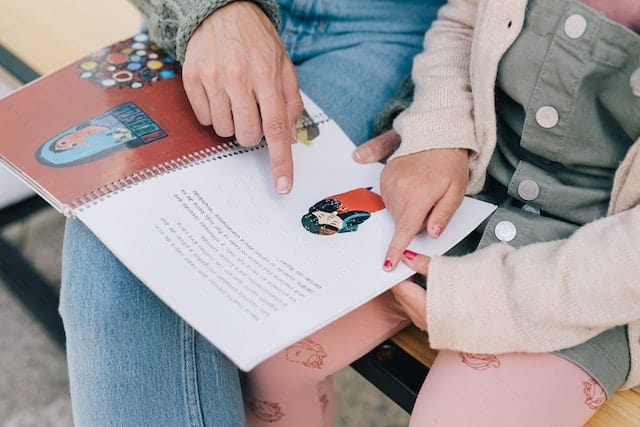Many parents wonder if their three-year-old child is ready to read. While some children may show an interest in letters and words at this age, it is not typical for them to read fluently. Understanding the cognitive abilities of three-year-olds can help parents and educators support their journey towards reading.
Three-year-olds are in the early stages of developing their cognitive abilities. They are learning to use language to express their thoughts and feelings, and they are starting to understand basic concepts such as colors, shapes, and numbers.
While some children may be able to recognize a few letters or words, most three-year-olds are not yet ready to read.
Key Takeaways
- Three-year-olds are in the early stages of developing their cognitive abilities and are not typically ready to read fluently.
- Reading is important to children’s development and can be supported through teaching strategies and the use of technology.
- Preschool can play a role in reading development, but parents and caregivers can also support their child’s journey towards reading at home.
Understanding 3-Year-Olds’ Cognitive Abilities

1. Language Acquisition
At the age of 3, children have already acquired a significant amount of language skills. They can understand and use a wide range of vocabulary, and they are able to form simple sentences.
However, their language skills are still developing, and they may struggle with more complex grammar and vocabulary.
At this stage, it’s important for parents and caregivers to continue to expose children to a rich language environment. This includes reading books, singing songs, and talking to them about their surroundings.
By doing so, parents can help children expand their vocabulary and improve their speech and language skills.
2. Recognition of Letters and Numbers
While most 3-year-olds are not yet able to read, they may be able to recognize some letters and numbers. They may be able to identify the letters in their name, as well as numbers up to 10.
However, this ability varies widely among children, and some may not be able to recognize any letters or numbers at this age.
To help children develop their letter and number recognition skills, parents can use a variety of techniques. This includes pointing out letters and numbers in their environment, playing games that involve letters and numbers, and reading books that focus on these concepts.
It’s important to keep in mind that every child develops at their own pace, and there is no need to rush their development.
By providing a language-rich environment and engaging in activities that promote letter and number recognition, parents can help their child develop important cognitive skills that will serve them well in the years to come.
The Journey to Reading
Learning to read is an essential milestone in a child’s life. However, the journey to reading can be a challenging one for both the child and the parent. This section will explore the different stages a child goes through on their journey to reading.
1. Learning the Alphabet
The first step in learning to read is learning the alphabet. Children are usually introduced to the alphabet through the alphabet song, which is a fun and engaging way to learn the letters. Parents can also use flashcards or books to help their child learn the alphabet.
2. Introduction to Phonics
Once a child has learned the alphabet, the next step is to introduce them to phonics. Phonics is the study of the sounds that letters make, and it is an essential part of learning to read. Children can learn phonics through games, books, and worksheets.
By learning phonics, children can start to sound out words and read simple sentences.
3. Grasping the Concept of Words
As a child becomes more comfortable with phonics, they will start to grasp the concept of words. They will learn that words are made up of individual sounds, and they can use their knowledge of phonics to decode words. Children will also start to learn new vocabulary and be able to read written words.
Overall, the journey to reading is a gradual process that requires patience and persistence. By introducing children to the alphabet, phonics, and the concept of words, parents can help their child develop the skills they need to become confident readers.
Importance of Reading to Children

Reading to children is one of the most important things that parents and caregivers can do to help them develop language and literacy skills. While some parents may think that reading to a 3-year-old is unnecessary, research shows that it is actually beneficial for their cognitive and emotional development.
1. Benefits of Reading Aloud
Reading aloud to children has many benefits. It helps them develop language skills, including vocabulary, comprehension, and grammar. It also improves their listening skills and attention span.
Children who are read to regularly have been shown to perform better in school and have a greater love for learning.
In addition, reading aloud to children can help them develop empathy and emotional intelligence. Stories provide a safe space for children to explore different emotions and learn how to deal with them in a healthy way.
It can also help them understand and relate to others, which is an important skill for social interactions.
2. Role of Board Books
Board books are a great way to introduce reading to young children. They are durable and can withstand the wear and tear of little hands. They also have simple, colorful illustrations and short, easy-to-understand sentences.
Board books help children develop their fine motor skills by allowing them to turn pages and point to pictures. They also help children learn the basics of how books work, such as reading from left to right and top to bottom.
Overall, reading to young children is an important activity that can have lasting benefits. Whether it’s through board books or more advanced literature, parents and caregivers should make reading aloud a regular part of their child’s routine.
Reading Milestones for 3-Year-Olds
1. From Left to Right Reading
At the age of three, children typically begin to understand the concept of reading from left to right. They start to recognize that words and sentences have a specific order and that they need to follow that order to make sense of what they are reading.
To help children develop this skill, parents and caregivers can encourage them to follow along with a finger or a pointer as they read aloud. This will help children understand that words and sentences are read in a specific order and will prepare them for more advanced reading skills in the future.
2. Understanding Simple Plots
Three-year-olds also begin to understand simple plots in books. They can follow a story and recognize the beginning, middle, and end. They may also be able to predict what will happen next based on the story’s context.
To help children develop this skill, parents and caregivers can ask questions about the story as they read aloud. For example, they can ask what the characters are doing or what might happen next. This will help children develop their comprehension skills and prepare them for more complex stories in the future.
Teaching Strategies for Early Reading

Teaching a three-year-old to read can be a daunting task, but it is possible with the right strategies. Here are some effective strategies to help teach early reading:
1. Using Rhyming Games
Rhyming games are a fun and effective way to teach children how to read. Rhyming helps children develop phonemic awareness, which is the ability to hear and identify individual sounds in words. Here are some examples of rhyming games that can be used to teach early reading:
- Singing nursery rhymes and songs that have a lot of rhyming words.
- Playing games that involve rhyming, such as “I Spy” or “Rhyme Time.”
- Reading books that have a lot of rhyming words, such as Dr. Seuss books.
2. Incorporating Drawing and Writing
Drawing and writing can also be effective tools for teaching early reading. Here are some ways to incorporate drawing and writing into early reading lessons:
- Encourage children to draw pictures of the words they are learning to read.
- Have children practice writing the words they are learning to read.
- Use flashcards with pictures and words to help children associate the two.
By using these strategies, parents and teachers can help three-year-olds develop the skills they need to become successful readers.
Role of Preschool in Reading Development
Preschool plays a crucial role in the reading development of children. It is during this time that children learn the foundational skills necessary for reading and writing.
1. Transition to Longer Books
Preschoolers are introduced to longer books that have more complex storylines and characters. This helps them to develop their listening and comprehension skills. They learn to follow a story from beginning to end and understand the plot and characters.
2. Introduction to Punctuation and Capitalization
Preschoolers are also introduced to the basics of punctuation and capitalization. They learn about the different types of punctuation marks, such as periods, commas, and question marks, and how they are used in sentences.
They also learn about capitalization and the importance of using capital letters at the beginning of sentences and for proper nouns.
Overall, preschool provides a solid foundation for reading development. Children learn the necessary skills and knowledge to become successful readers and writers. By the time they enter elementary school, they are well-equipped to continue their reading journey.
| Key Takeaways |
|---|
| – Preschool plays a crucial role in reading development. |
| – Preschoolers are introduced to longer books to develop listening and comprehension skills. |
| – Preschoolers learn about punctuation and capitalization basics. |
Using Technology to Enhance Reading Skills
With the increasing use of technology in our daily lives, it is no surprise that it has become a useful tool in the education sector, especially in enhancing reading skills. There are many educational apps and tools available that can help young children develop their reading skills.
1. Educational Apps
Educational apps are designed to help children learn in a fun and interactive way. Many of these apps are specifically designed to enhance reading skills. These apps use various techniques such as phonics, sight words, and interactive games to help children improve their reading skills. Some popular apps include:
- ABCmouse
- Reading Eggs
- Hooked on Phonics
- Starfall
These apps are designed to be user-friendly and engaging for young children. They help children learn at their own pace and provide feedback to parents on their child’s progress.
2. Role of Reading Specialists
While technology can be a useful tool in enhancing reading skills, it is important to note that it cannot replace the role of reading specialists. Reading specialists are trained professionals who work with children to improve their reading skills.
They can provide personalized instruction and support to children who are struggling with reading.
Reading specialists can work with children one-on-one or in small groups to provide targeted instruction based on the child’s needs. They can also work with teachers and parents to develop strategies to support the child’s reading development.
In conclusion, technology can be a useful tool in enhancing reading skills, but it cannot replace the role of reading specialists. Educational apps can be a fun and interactive way for young children to develop their reading skills, but they should be used in conjunction with targeted instruction from a reading specialist.
Conclusion
In conclusion, while some 3-year-olds may show an interest in letters and words, it is unlikely that they have developed true reading skills. The ability to read requires a complex set of cognitive skills that typically develop over time with practice and exposure to language and reading materials.
While some children may appear to be reading at a young age, it is more likely that they have memorized the words through repetition or have learned to recognize certain letters or patterns. This is not the same as true reading, which involves understanding the meaning and context of written language.
It is important for parents and caregivers to support children’s language development by reading aloud, talking with them, and providing access to books and other reading materials.
However, it is also important to recognize that each child develops at their own pace and not to put pressure on young children to read before they are developmentally ready.
Overall, while it is possible for some 3-year-olds to display an interest in reading, it is not typical for them to have developed true reading skills at this age.
Related: Can 4 Year Olds Read
Frequently Asked Questions
What is the earliest age a child can learn to read?
Children can begin to learn the basics of reading as early as 2 years old. However, every child is different, and some may not be ready to learn until they are a bit older.
How can I teach my 3 year old to read?
There are a variety of methods that can be used to teach a 3 year old to read. Some effective strategies include reading to them regularly, using flashcards and other visual aids, and playing word games.
Is it normal for a 3 year old to read?
While it is not common for a 3 year old to read fluently, it is possible for them to recognize and sound out simple words. However, it’s important to remember that every child develops at their own pace.
What are some good books for a 3 year old learning to read?
Some good books for a 3 year old learning to read include simple picture books with short words and sentences, such as “The Cat in the Hat” and “Green Eggs and Ham” by Dr. Seuss.
What are some effective learn-to-read programs for young children?
There are many effective learn-to-read programs available for young children, such as “Hooked on Phonics” and “Reading Eggs”. These programs use a variety of methods, including phonics and sight words, to help children learn to read.
At what age should a child be able to read fluently?
Most children are able to read fluently by the age of 7 or 8. However, it’s important to remember that every child develops at their own pace, and some may take longer to reach this milestone.

Iesha is a loving mother of 2 beautiful children. She’s an active parent who enjoys indoor and outdoor adventures with her family. Her mission is to share practical and realistic parenting advice to help the parenting community becoming stronger.
